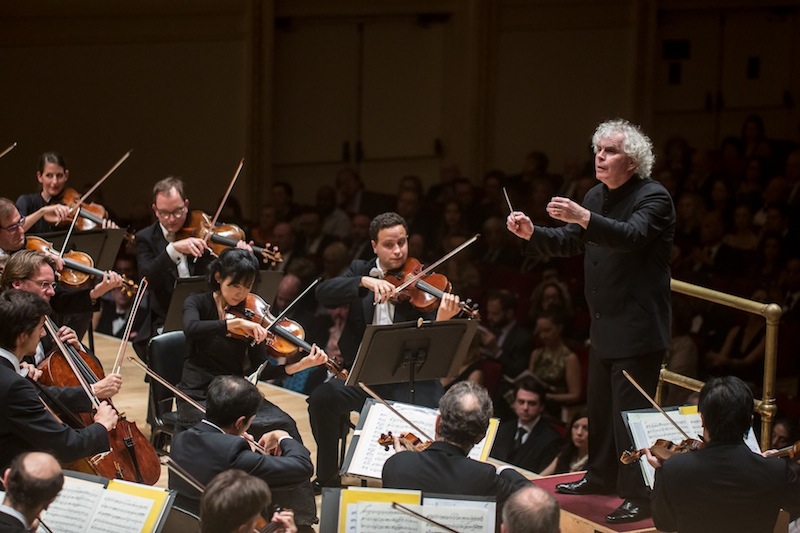Rattle, Mutter and Berlin Philharmonic open Carnegie season in memorable fashion

Sir Simon Rattle and the Berlin Philharmonic Orchestra opened Carnegie Hall’s season Wednesday night. Photo: Rob Davidson/Berliner Philharmoniker
It’s almost unfair, the way Carnegie Hall is able to tower over New York’s other concert presenters. It seems as though every time another outfit puts together an exciting program, Carnegie is able to up the ante: “I’ll see your Mahler 9…and I’ll raise you the Royal Concertgebouw.” That the presence on Seventh Avenue of the world’s greatest orchestras, soloists, and chamber musicians has become so routine is simply miraculous.
On Wednesday night, Carnegie opened its season by welcoming in Sir Simon Rattle and the legendary Berlin Philharmonic Orchestra. Opening with a set of orchestral favorites, Rattle’s first program was not the most adventurous ever devised. But the extraordinary quality of the playing left no doubt as to the rewards that lie ahead during the group’s week-long New York sojourn.
From the very beginning of Rachmaninoff’s Symphonic Dances, you could hear why this orchestra has such a formidable reputation. A huge, meaty texture and sharp articulation in the early going captured the piece’s bombastic side. There was something just the slightest bit grungy about their playing, as Rattle allowed his players to dig deep into the strings. Crackling warmth established the melancholy nostalgia of the waltz before the flighty finale as plush sound reached out into the auditorium.
Bruch’s First Violin Concerto (the Second and Third are practically unknown) manages to cling to its place in the concert repertory even though its place in the violin repertoire is less august. It’s never been the piece that defined any violinist’s career, nor are comparisons of interpretations likely to provoke heated debate, as the Tchaikovsky concerto does with the recordings of Heifetz and Oistrakh. Flashy and romantic, it is an enduring audience favorite, even if it never gets first billing.
Anne-Sophie Mutter, still the most glamorous violinist in the world after a thirty-some year career, has the requisite star power to rattle off a sensational performance of this concerto, and she did just that. She was fiercely assertive in the first movement, employing idiomatic turns of phrase that put her unique stamp on the piece. Rattle led an intense, pulsating accompaniment.
The Adagio showed Mutter at her most rhapsodic, as she brought a taut, golden tone and laser precision to the reverential melody. Strong communication allowed her to change her color completely just before the final climax, as Rattle brought the orchestra down to a bare whisper. In the finale, Mutter’s playing was pure, effervescent joy. A momentary memory lapse found her suddenly in the wrong key, but she was completely unfazed, quickly finding her way again and driving the piece home to a thrilling finish.
Finishing off with the closing scenes of Stravinsky’s Firebird, Rattle brought his players in on a powerful, almost ear-splitting opening chord. The orchestra maintained a crisp, cackling marcato throughout the “Infernal dance” before weaving a thick carpet of sound in the final transitional bars.
The Berceuse was rapturous, from the haunting solo passed among the winds at the start to the ethereal transition into the finale. The pianissimo tremolo was about the softest you’ll ever hear a string section play while still producing a consistent tone. The effect was astonishing, and set up a stirring and majestic finale.
The Berlin Philharmonic will perform Rachmaninoff’s Symphonic Dances and Stravinsky’s The Firebird (complete) 8 p.m. Thursday at Carnegie Hall. carnegiehall.org






